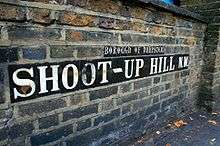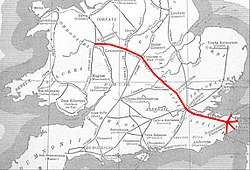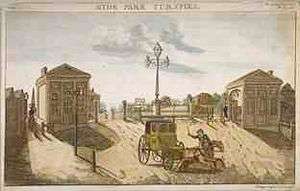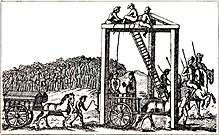Edgware Road
Edgware Road is a major road through north-west London, starting at Marble Arch in the City of Westminster (south end) and running north to Edgware in the London Borough of Barnet. It is also a boundary between several North London boroughs. The route has its origins as a Roman road (part of Watling Street) and therefore runs for 10 miles in an almost perfect straight line, which is unusual in London. It is part of the modern A5 road. It undergoes several name changes along its length, including Maida Vale, Kilburn High Road, Shoot Up Hill and Cricklewood Broadway; but the road is, as a whole, known as the Edgware Road, as it is the road to Edgware.
Edgware Road at Paddington | |
| Length | 9 mi (14 km) |
| Location | London, United Kingdom |
| Postal code | W2 |
| North end | Edgware |
| West end | Marble Arch |
| Construction | |
| Construction start | 43 A.D. |
| Other | |
| Known for | Shopping, Lebanese cuisine, Marble Arch, Gaumont State Cinema, Tricycle Theatre, St Augustine's, Kilburn, |
Route
The road runs north-west from Marble Arch to Edgware on the outskirts of London. It crosses the Harrow Road and Marylebone Road, passing beneath the Marylebone flyover. The road passes through the areas of Maida Vale, Kilburn and Cricklewood. It then crosses the North Circular Road before West Hendon at Staples Corner. After this, the road continues in the same direction, through the Hyde, Colindale, Burnt Oak, and then reaches Edgware.

The southernmost part of the Edgware Road forms part of the London Inner Ring Road and as such is part of the boundary of the London congestion charge zone. However, when the zone was extended in February 2007, the road became part of the "free through routes" which allows vehicles to cross the zone during its hours of operation without paying the charge.
The southern part of the road between Marble Arch and Maida Vale, noted for its distinct Middle Eastern cuisine and many late-night bars and shisha cafes, is known to Londoners by nicknames such as Little Cairo,[1][2] Little Beirut[3] and, especially near Camden, Little Cyprus.[4][5]
As it passes through the various neighbourhoods, the road name changes several times, becoming Maida Vale, Kilburn High Road and Shoot-Up Hill (in Kilburn), and Cricklewood Broadway (in Cricklewood), before becoming Edgware Road once again with intermittent stretches as West Hendon Broadway, and the Hyde. Along the entire route, it retains its identity as the A5 road under the Great Britain road numbering scheme. The A5 continues beyond the end of the Edgware Road, following the old Roman road for much of its route and terminating at Holyhead, Wales (a port for Ireland).
History


Before the Romans, today's Edgware Road began as an ancient trackway within the Great Middlesex Forest.[6] The Romans later incorporated the track into Watling Street.[6]
Many centuries later, the road was improved by the Edgware-Kilburn turnpike trust in 1711, and a number of the local inns, some of which still exist, functioned as stops for coaches, although they would have been quite close to the starting point of coach routes from London.
During the 18th century, it was a destination for Huguenot migrants.[6] By 1811, Thomas Telford produced a re-design for what was then known as a section of the London to Holyhead road, a redesign considered one of the most important feats of pre-Victorian engineering.[6] Telford's redesign emerged only a year after the area saw the establishment of Great Britain's first Indian restaurant.[6]
The area began to attract Arab migrants in the late 19th century during a period of increased trade with the Ottoman Empire. The trend continued with the arrival of Egyptians in the 1950s, and greatly expanded beginning in the 1970s and continuing to the present when events including the Lebanese Civil War, the overthrow of the Shah of Iran, and unrest in Algeria brought more Arabs to the area.[6] They established the present-day mix of bars and shisha cafes, which make the area known to Londoners by nicknames such as "Little Cairo"[2][7] and "Little Beirut."[3] These shisha cafés have been hard hit by the enforcement of the England-wide smoking ban in 2007.
One of the two Edgware Road tube stations was one of the sites of the 7 July bombings. A bomb was detonated on a train leaving the tube station serving the Circle, District and Hammersmith & City lines and heading for Paddington tube station. Six people were killed in the blast: Colin Morley, 52, Jennifer Vanda Ann Nicholson, 24, Johnathan Downey, 34, Laura Webb, 29, Michael Brewster, 52, and David Foulkes, 22. The perpetrator was the ringleader of the 7 July bombings, Mohammed Siddique Khan. On the first anniversary of the bombings, a memorial plaque to the victims was unveiled at the station.
Districts and surrounding area
The name "Edgware Road" is used to refer to informally to this area of London, meaning the area immediately to the north of Marble Arch. The district's northern boundary is the Marylebone flyover.[6]
The postal codes of the area are W1, W2, NW1 and NW2.
The part of the road between Marble Arch and the Marylebone Flyover also separates the areas of Marylebone and Bayswater.

The southernmost part of the road, south of the junction with Marylebone Road, is noted for its distinct Middle Eastern flavour. Many Lebanese restaurants, shisha cafes and Arabic-themed nightclubs line the street. The Odeon cinema, once the location of the biggest screen in London, often shows films in Arabic.
Edgware Road is over represented in terms of ethnic culture, and is in a very central area of London.[8] The area is known for its population of communities from across the Middle East and Africa.

- A Wetherspoons tavern, The Tyburn, is named after the 'Tyburn tree', once the principal site of execution in London. Today, three golden triangles indicate the location of the tree, at the southernmost end of Edgware Road. N.B. The pub has closed as the building on this site is being redeveloped throughout 2018.
Transport
Edgware Road has several London bus routes, and is intersected by several London Underground lines along its length.
A number of schemes have been put forward in the past to construct an Underground railway line underneath Edgware Road, including a plan to extend the Bakerloo line north to Cricklewood and an unusual proposal to build an underground monorail system,[9] but these schemes did not succeed. Today, London Buses provide the only public transport along the length of the road.
London Underground
- Edgware Road (Bakerloo line)
- Edgware Road (Circle, District and Hammersmith & City lines)
- Marble Arch (Central line)
- Marylebone (Bakerloo line)
- Paddington (Bakerloo, Circle, District and Hammersmith & City lines)
- Kilburn (Jubilee line)
London Overground
Bus routes
Night bus N16 is the only route to run the full length of the Edgware Road, from Victoria station to Edgware.
Day bus routes operating over a significant length of Edgware Road are:
References
- Times Online: London high life hit as rich Arabs decamp, retrieved 29/03/07
- Telegraph: Never talk about what you wear...
- This Is London: Little Beirut
- Anthony, Andrew, "A Kentish Town killing", The Observer, 18 June 2000
- Clough, Eric A. and Quarmby, Jacqueline, (1978). A public library service for ethnic minorities in Great Britain, ISBN 978-0-85365-890-0, p.71
- Working for the future of Edgware Road, a 2006 planning document (in PDF format) from the City of Westminster website
- Times Online: London high life hit as rich Arabs decamp, retrieved 29 March 2007
- BBC: Arabic London, retrieved 7 October 2007
- Badsey-Ellis, Antony (2005). London's Lost Tube Schemes. Capital Transport. ISBN 1-85414-293-3.
External links
| Wikimedia Commons has media related to Edgware Road. |